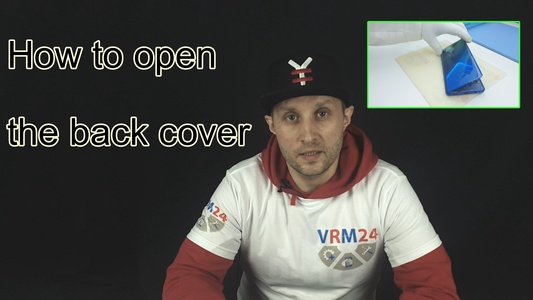
Hello guys, my name is Vadim, and today I will describe one of the ways to open the smartphone's back cover. This guide is suitable for most smartphone models with a cover glued to the housing BUT, not for covers with a fingerprint sensor attached to it.
 SM-A920 vrm24com 1.jpg)
Well, let's get started!
In our guide, we will use a Samsung Galaxy A9 (2018) SM-A920 smartphone. We will heat it on a heating mat. We will use isopropyl alcohol and several thin plastic sheets to separate. A short story about it. These plastic sheets are protecting films for new displays. We have a lot of such goods in our workshop, so we figured out how to adapt and use them in our work.
 SM-A920 vrm24com 3.jpg)
Under the cover, there are cameras, cables, and a fingerprint sensor. If you are afraid of damaging anything, I have two tips for you...
- First - do not push the plastic too deep (one centimeter or half-inch is enough)
- and Second - look where the cables and other elements are located under the cover.
For example, open our website, look at the model, instructions, what step the back cover is located on, and look at the location of everything. So it may be that your model is not represented on our website - so choose another website or video on any video platform.
 SM-A920 vrm24com 4.jpg)
Now, we understand that the back cover is glued, adhesive along, and not far from the edge, the fingerprint sensor is attached to the middle cover. There are several flat cables, and the protective glass for cameras is built into the back cover. We have information to proceed to open the back cover.
We have already heated the surface of the back cover to 70° C or 158° F, and for this, we used a heating mat to soften the adhesive base.
 SM-A920 vrm24com 2.jpg)
First, we are trying to find a weak spot in the adhesive enough to push the plastic sheet. Usually, it's a corner.
We pry off the cover, push the plastic sheet inside a half-inch so as not to damage anything, and begin to move the plastic to separate the cover from the housing. We often use isopropyl alcohol. We spray alcohol on the sheet. The liquid flows down to the gap, getting and drying the adhesive base. We do this many times to save the adhesive and open the back cover faster.
 SM-A920 vrm24com 6.jpg)
If! The adhesive base still holds the cover firmly. Put the smartphone back to the heating mat or heat it up with a heat gun for a few more minutes and continue the separation.
It is always important to remember that - it is not recommended to use isopropyl alcohol at the location of the cameras. Just carefully pass the plastic sheet along the edge. If alcohol gets on the cameras, there is a probability of damage to the lenses.
Be careful! We are primarily responsible for our repair. If something doesn’t move somewhere, you don’t need to try to act by force. It is better to look at some video, or another video, or look for information on forums and thematic websites, etc.
It often happens that we try to open the cover, and it seems like it turns out to slightly lift the cover up, but on the one hand, it seems to be holding something. So, we take the plastic sheet again and carefully pass along the cover in the place where the adhesive still holds the back cover.
 SM-A920 vrm24com 7.jpg)
And now we have no more obstacles to opening. We open the back cover. See how the adhesive is preserved, where and what it is located, if necessary, take pictures so as not to confuse anything or accidentally forget during disassembly, assembly, repair, etc.
 SM-A920 vrm24com 8.jpg)
In the end, I want to answer another often asked question - how would we rate the chance of reusing the original adhesive - in our case 100%, for the third or fourth time, it will most likely not work to glue this back cover again. The adhesive base will simply dry out from alcohol.
 SM-A920 vrm24com 9.jpg)
Now we're done. Be careful in repair and life!
If you have a question, ask us, and we will try to answer in as much detail as possible. If this article was helpful for you, please rate it.
